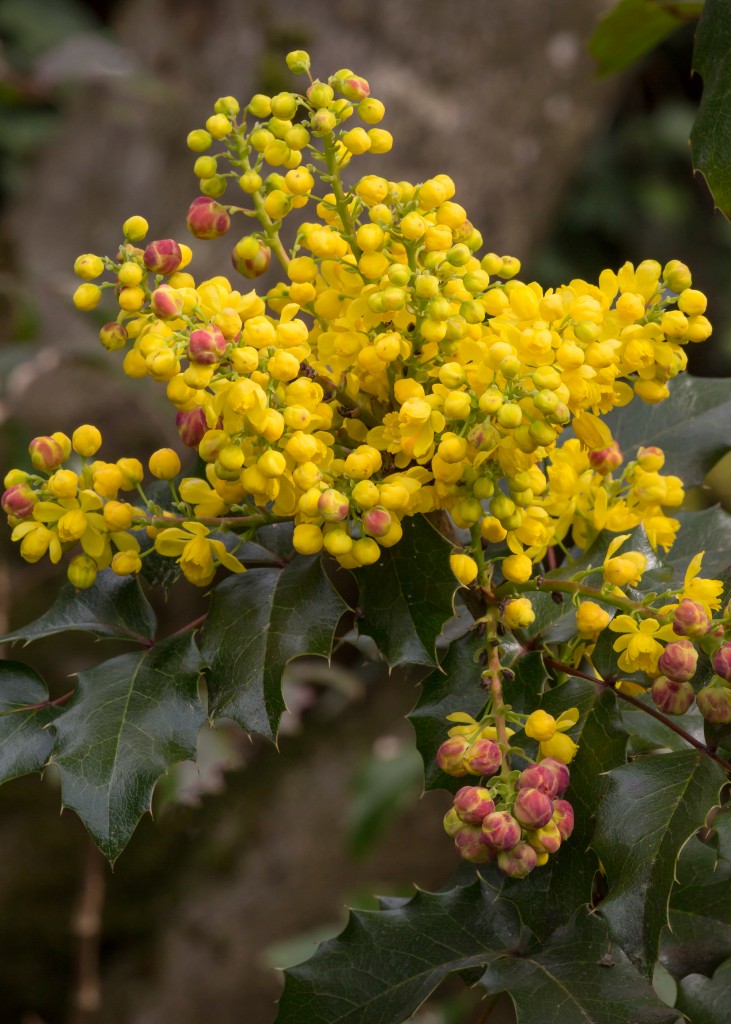
Plan ahead for hungry native pollinators who need early-flowering plants like red-flowering currant to survive.
April showers may bring May flowers, but what about providing forage for hungry pollinators that need food earlier in the year? To provide large amounts of nectar and pollen in late winter and early spring for emerging bees as well as hummingbirds and other pollinators, to help you endure the gray winter skies and store carbon, and to get the most bang from your buck, add early-flowering native shrubs to your garden. Get new shrubs in the ground preferably in autumn—so the plants benefit from winter rains, and to ensure that you have the early part of a continuous succession of flowers covered.
Here are five early-flowering shrubs (plus one shrubby tree that’s pollinated by wind), listed in order of size from largest to smallest, that naturally occur in large areas of the Pacific Northwest region west of the Cascades. They grow in sun to partial shade, are fairly easy to find at native plant nurseries (as well as nurseries that don’t focus on natives), and are quite easy to grow, provided they are kept adequately moist until they are established (2 to 5 years). All would do well planted in wide, unpruned hedgerows. When choosing any shrub, note its eventual width to be sure you have enough space for it to stretch its limbs and attain its natural form at maturity—and to eliminate future hack jobs by a pruner.
Buy plants that are responsibly propagated from source material that originated as close as possible to your site. Using such “local genotypes” helps ensure that you get plants that are well adapted to your area and that genetic diversity—which helps plants (and animals) adapt to changing conditions—is preserved. Ask growers and nurseries about their sources.
 Scouler’s willow (Salix scouleriana): A fast-growing deciduous shrub or small tree. Flowers are soft catkins, larger than horticultural “pussy willows,” and appear in early to mid-spring. Male and female flowers are on different plants, so grow both for seeds. Scouler willow is a larval host plant for several butterfly species. Does not tolerate full shade. Prefers moist soil. 20-30 feet tall by 10-15 feet wide at maturity.
Scouler’s willow (Salix scouleriana): A fast-growing deciduous shrub or small tree. Flowers are soft catkins, larger than horticultural “pussy willows,” and appear in early to mid-spring. Male and female flowers are on different plants, so grow both for seeds. Scouler willow is a larval host plant for several butterfly species. Does not tolerate full shade. Prefers moist soil. 20-30 feet tall by 10-15 feet wide at maturity.

Osoberry (Oemleria cerasiformis): A large, arching deciduous shrub or small tree that blooms prolifically in late winter as leaves emerge. Tolerates clay soil well, but does best with some shade (nature places it in the dappled shade of tall trees). Plants are either male or female, so plant several to produce the fruit that birds need. 12-18 feet by 10-14 feet at maturity.

Serviceberry (Amelanchier alnifolia): A versatile, multibranched shrub with lovely white, fragrant flowers in mid to late spring. Bluish-green leaves turn gold to reddish in autumn. Larval host plant for several butterfly species. Needs well-drained soil with adequate organic matter. Tolerates full sun in cool areas. Doesn’t like competition, so plant other shrubs and perennials at least several feet away. 8-18 feet tall by 6-10 feet wide at maturity.
Red-flowering currant (Ribes sanguineum): An upright, deciduous shrub with nearly year-round appeal. Gorgeous, pendulous, lightly fragrant flower clusters (pictured, top) that bloom in early spring are followed by powder-blue berries. Leaves turn golden in late autumn. Larval host plant for butterfly larvae. Controls erosion. Can’t handle excessively wet soils, so be sure soil drains well and plant it away from rain gardens and other drainage areas. 7-10 feet tall by 6-9 feet wide at maturity. More info in this post.
 Tall Oregon grape (Mahonia aquifolium): A handsome, multitalented evergreen shrub with an upright growth habit. Bursts into flower brilliantly in early to mid-spring, for a long period. Tolerates acidic soils. Has somewhat prickly evergreen leaves, so site it where it won’t be brushed against frequently. 5-9 feet tall by 3-6 feet wide. Will spread slowly. More info in this post.
Tall Oregon grape (Mahonia aquifolium): A handsome, multitalented evergreen shrub with an upright growth habit. Bursts into flower brilliantly in early to mid-spring, for a long period. Tolerates acidic soils. Has somewhat prickly evergreen leaves, so site it where it won’t be brushed against frequently. 5-9 feet tall by 3-6 feet wide. Will spread slowly. More info in this post.
The earliest winter bloomer is the handsome beaked hazelnut (Corylus cornuta var. californica), a beautifully textured, large multistemmed woodland shrub or small tree that grows to 10-20 feet tall by 10-20 feet wide. It is pollinated by wind, not animals. More info here.
After planting
Add a few inches of organic matter as mulch around the shrub (but keep away from trunk) to insulate, keep weeds down, and add nutrients. Fallen leaves work well, as does weed-free compost. If you use wood chips, make sure they aren’t finely ground and/or fresh, and don’t dig them into soil—under-composted chips and bark can deplete soil of nitrogen during breakdown. Later on, simply allow fallen leaves to remain on soil to provide habitat and nutrients.
All of these shrubs are drought tolerant when established (although Scouler willow does best with supplemental summer water), but they will appreciate some irrigation in very hot situations. They should need little to no pruning if they’ve been sited to allow room for their growth.
If you already grow any of these shrubs, I’d love to hear what wild species you’ve seen attracted to them. Or how much they brighten your garden on drab winter days?
To leave a comment, click on post’s title